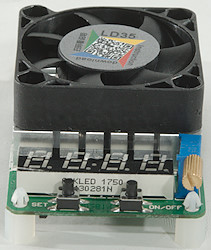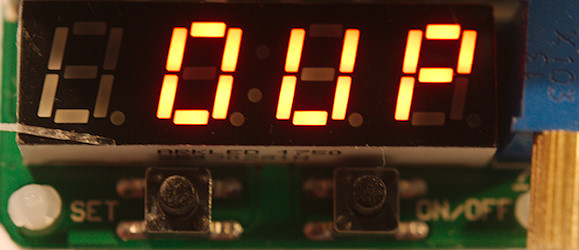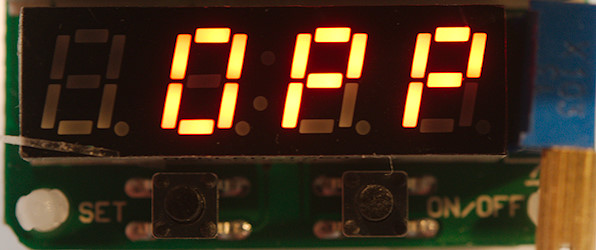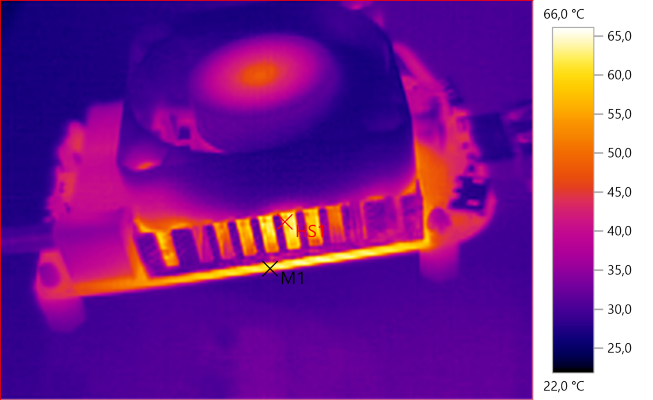RD Electronic USB load LD35

Official specifications:
- Rated operational voltage: DC 4-25.0V
- Max discharging power: 35W
- Rated operational current: 0.25-5.00A (when fan don’t work, the minimum constant current is 0.05A )
- Fan Speed: Large size intelligent temperature control fan, speed 8000±10%RPM
- Constant current resolution:±1% +3 digits
- Heat dispatch method: intelligent temperature control fan + All aluminum fan
- Working temperature: -10°C ~ 40°C
- Adjustable potentiometer: Precision multiloop adjustable potentiometer
- Display mode: 4 bit LED tube
- Expansion port: Micro USB port, Type-C port
I got it from Aliexpress dealer: RD official store

I got it in the usual styrofoam box (That is RD's standard packing) together with some other stuff, inside the box it was wrapped in bubble wrap.

At one end is the two buttons, the current adjustment and the display, at the other end is the 3 usb connectors (Micro, A and C), between is the heatsink and fan.

I will take a closer look at the circuit further down.






The SET button is used to change between different readings, here is the current, it will flash when the load is off and be steady when the load is on.

Actual power dissipated by the load.

Input voltage, this is the voltage feed into the load.


Overload conditions will disable the load and show a warning on the display. Here over power protection (OPP) and over voltage protection (OUP)
Holding the SET button down will toggle automatic resume on/off.
Holding the On/Off button down will toggle automatic on when power is connected.
Load testing
- Current resolution is 0.01A
- Voltage resolution is 0.1V
- Power resolution is 0.1W
- Internally current is adjusted in 0.01A steps, it is not analog!
- Load is rated to handle 30V before being damaged, load shows OUP between 25V and 30V
- Current adjustment range is from 0.00A to 5.09A, but supported range is from 0.05A to 5.00A
- The load has USB-A, micro usb and USB-C connectors, all in parallel.
- USB-C connector will not turn USB-C output on!
- Voltage display shows voltage at input, any voltage drop is due to connector and cable resistance.
- I got about 0.12V drop for connection and other resistance in usb load at 5A (Current in on A, check on C).
- Current change during 60 minutes with 1.4A load at 24.9V is 0.0005A, i.e. 0.4%
- Current change during 60 minutes with 5A load at 6.9V is 0.007A, i.e. 1.4%
- The adjustment is a multiturn potentiometer and the display will show the selected current.
- The fan is audible, but not loud, it starts and stops as required (This is a bit annoying).
- Current when off about 17mA for the electronic and display.


Both current and voltage readout has good precision.

Due to the power limit of 35W it is not possible to test with high current and high voltage, here I had enabled automatic recovery, i.e. load would turn on when the voltage was low enough. On many of the high current traces the fan was running when I started at the high voltage, but would stop when the load had cooled down.

Here is a trace with adjustment in minimum position and low current traces. The load has an offset of some mA at these low currents.

I tried two 1 hour test, one at maximum voltage (I used 24.9V and 1.4A) and one at maximum current (I used 6.9V and 5A).

M1: 44.5°C, M2: 49.1°C, HS1: 52.3°C
First set of thermo photos is from 24.9V 1.4A test

M1: 61.0°C, HS1: 66.0°C

M1: 81.1°C, HS1: 91.6°C
Both transistor and regulator warms up with high input voltage.

M1: 44.3°C, M2: 48.3°C, HS1: 53.0°C
Next set of thermo photos is from 6.9V 5A test

HS1: 69.4°C

M1: 97.7°C, HS1: 111.8°C
With lower input voltage the transistor must handle all the power and gets a bit warmer, the shunt resistor do also get warm at 5A
A look at the circuit

The transistor (TIP122) is the load element, it uses a resistor (R6: 0.025ohm) to sense the current. The fan is a 5V version and has its own regulator (LM317), at high input voltage it must handle some power. Turning the fan on/off is handled by a small transistor (Q2), the temperature sensor is very close to the TIP122 transistor and is a NTC (RT1) that is connected to the MPU.
The electronic has its own voltage regulators (U6: M5350B 5V, IC7:5333B 3.3V). The control of the load current is done with some OpAmps (U2 & U7: 358). The brain in the circuit is a 8051 microprocessor (U1: N76E003AT20 18KB Flash, 1k RAM, 12 bit ADC). For the display a 8 bit shift register (74HC595) is used to get more output pins.
Why 4 OpAmp (358 is a dual OpAmp), a load only need one OpAmp. A look at the circuit shows some filters connected to the MPU on U7. One filter is R11, R12, C8 and C9, the other filter is R15, R16, C14 and C15.

Filter input from microprocessor at 0.5A

Filter input from microprocessor at 3A
The R15 etc. filter is for fine adjustment and R11 etc. filter is for coarse adjustment.

The above PWM frequency is 1kHz, is there any trace of it on the output? To test that I used my current clamp to check the load current, there is no trace of the 1kHz PWM frequency.
Conclusion
The load works fine and with the multiturn adjustment and display it is easy to adjust. It has no problems handle the rated 35W power. It is not for low loads, the display and adjustment do not have resolution for it and it also need some minimum current to work.
It is a interesting design choice that the analog current setting is sampled by the microprocessor and then output as two PWM channels that is filtered and mixed, before being feed to the load regulation.
With USB-C I am missing the ability to turn outputs on (It is just a resistor), this will limit its usefulness for USB-C.
Notes
The load was supplied by RD for review.
The company also has a 25W load, main difference is the fan.




























